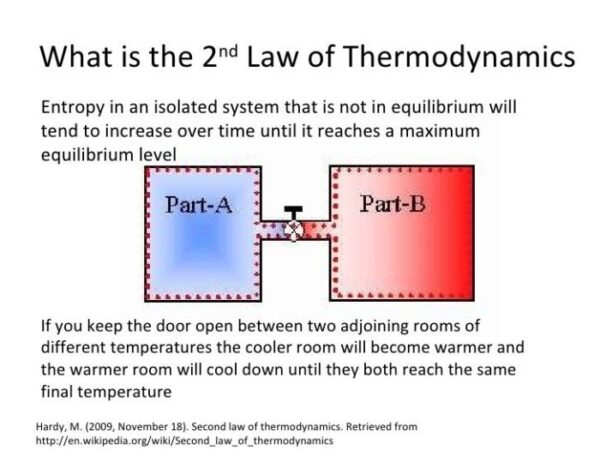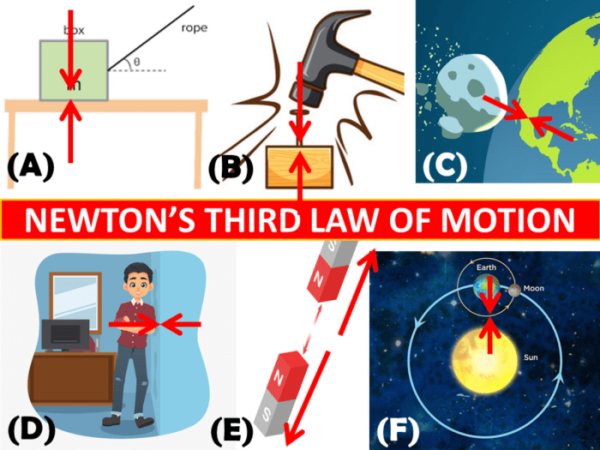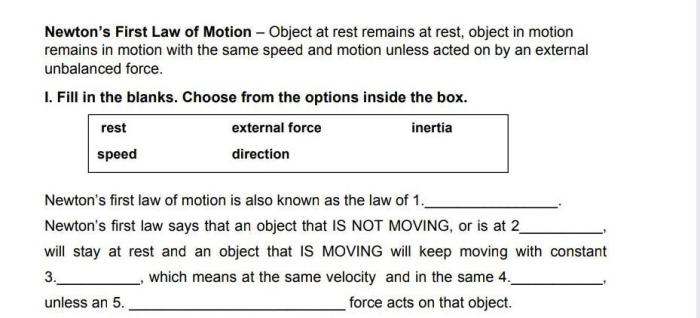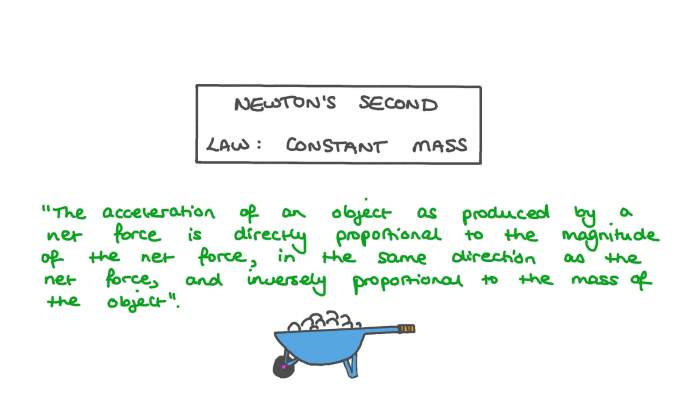
- Introduction to Newton’s Laws of Motion
- Statement of Newton’s First Law of Motion
- Examples of Newton’s First Law in Action: What Is Newton’s First Law Of Motion
- Understanding the Concepts of Force and Net Force
- The Relationship Between Force and Acceleration
- Applications of Newton’s First Law
- Ultimate Conclusion
- FAQ
What is Newton’s first law of motion? It’s a fundamental principle that governs the behavior of objects in motion and at rest. This law, often referred to as the law of inertia, forms the foundation of classical mechanics and helps us understand the movement of everything from planets to everyday objects.
Imagine a book sitting on a table. It remains stationary unless something pushes or pulls it. This stillness is due to inertia, the tendency of an object to resist changes in its motion. Similarly, a ball rolling across a field will continue rolling in a straight line at a constant speed unless a force acts upon it. This is another manifestation of inertia, the inherent resistance to changes in motion.
Introduction to Newton’s Laws of Motion
Newton’s laws of motion are fundamental principles in physics that describe the relationship between forces and the motion of objects. They form the basis for understanding how objects move in the universe, from the simple motion of a ball rolling down a hill to the complex orbits of planets around the sun.
Historical Context of Newton’s Contributions
Isaac Newton, an English physicist and mathematician, is credited with developing these laws in the 17th century. His groundbreaking work, *Philosophiæ Naturalis Principia Mathematica*, laid the foundation for classical mechanics and revolutionized our understanding of the physical world.
Newton’s laws of motion were not entirely new concepts. Ancient Greek philosophers like Aristotle had already proposed ideas about motion, but their explanations were often based on observations rather than rigorous mathematical principles. Newton, through his meticulous experiments and mathematical analysis, provided a more accurate and comprehensive framework for understanding motion. His work not only explained existing observations but also predicted new phenomena, such as the gravitational force between celestial bodies.
Statement of Newton’s First Law of Motion
Newton’s First Law of Motion, also known as the Law of Inertia, describes the behavior of objects in the absence of external forces. It lays the foundation for understanding how objects move or remain at rest.
Inertia
Inertia is a fundamental property of matter that describes an object’s resistance to changes in its state of motion. In simpler terms, an object at rest wants to stay at rest, and an object in motion wants to stay in motion.
An object at rest stays at rest and an object in motion stays in motion with the same speed and in the same direction unless acted upon by an unbalanced force.
The tendency of an object to resist changes in its motion is directly proportional to its mass. A more massive object possesses greater inertia and requires a larger force to alter its motion.
Examples of Newton’s First Law in Action: What Is Newton’s First Law Of Motion
Newton’s First Law of Motion, often called the law of inertia, describes how objects behave in the absence of external forces. In essence, it states that objects at rest tend to stay at rest, and objects in motion tend to stay in motion with the same speed and direction. We encounter examples of this law in our everyday lives.
Objects at Rest Remaining at Rest
Objects at rest will remain at rest unless acted upon by an unbalanced force. This means that if an object is stationary, it will continue to be stationary unless something pushes or pulls it.
- A book on a table will stay put unless someone picks it up or a strong gust of wind blows it off.
- A car parked on a level road will not move unless the driver starts the engine and applies the gas pedal.
- A ball sitting on the floor will remain still unless someone kicks it or a dog bumps into it.
Objects in Motion Continuing in Motion
Objects in motion will continue to move at a constant velocity unless acted upon by an unbalanced force. This means that if an object is moving, it will continue to move in the same direction and at the same speed unless something stops it or changes its direction.
- A hockey puck sliding across the ice will continue to move in a straight line at a constant speed until friction from the ice and air resistance slow it down.
- A train traveling at a constant speed on a straight track will continue to move at that speed and direction unless it encounters a curve, a change in elevation, or a braking force.
- A bicycle rolling down a hill will continue to move downhill until friction from the tires, air resistance, and gravity eventually slow it down.
Understanding the Concepts of Force and Net Force
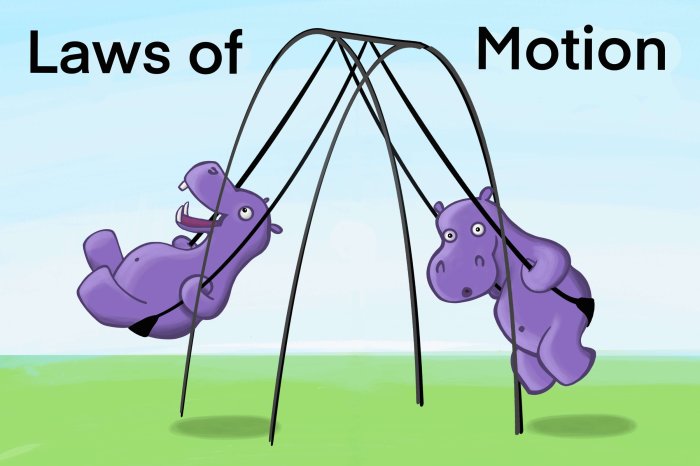
Newton’s First Law of Motion describes the behavior of objects in the absence of any forces acting upon them. However, to fully grasp this law and its implications, it’s crucial to understand the concepts of force and net force.
These concepts are fundamental to understanding how objects move and interact with their surroundings. They provide the foundation for understanding the other two laws of motion that Newton formulated.
Defining Force
Force is a push or pull that can change an object’s motion. It’s a vector quantity, meaning it has both magnitude (strength) and direction.
For example, when you push a box across the floor, you are applying a force to it. The force you apply has a specific magnitude (how hard you push) and a direction (the direction you push).
Force can have various effects on an object, including:
- Starting or stopping motion: Applying a force can cause a stationary object to start moving or bring a moving object to a stop.
- Changing an object’s speed: A force can increase or decrease an object’s speed. For example, pushing a swing harder makes it move faster, while applying brakes on a car reduces its speed.
- Changing an object’s direction: A force can cause an object to change its direction of motion. For example, turning a steering wheel in a car causes it to change direction.
- Deforming an object: Force can also deform an object, changing its shape. For example, squeezing a ball compresses it, and stretching a rubber band elongates it.
Understanding Net Force
Net force is the overall force acting on an object. It’s the vector sum of all the individual forces acting on the object. To understand this, imagine you are pushing a box across the floor. You are applying a force in one direction, but there are other forces acting on the box as well, such as friction from the floor and gravity pulling it downwards.
The net force is the combined effect of all these forces. If the force you are applying is greater than the opposing forces, the box will accelerate in the direction you are pushing. However, if the opposing forces are greater, the box will either remain stationary or move in the opposite direction.
Net force plays a crucial role in determining an object’s acceleration. This relationship is described by Newton’s Second Law of Motion, which states that the acceleration of an object is directly proportional to the net force acting on it and inversely proportional to its mass. This means that:
A larger net force will result in a greater acceleration, while a smaller net force will result in a smaller acceleration. An object with a larger mass will accelerate less than an object with a smaller mass under the same net force.
The Relationship Between Force and Acceleration
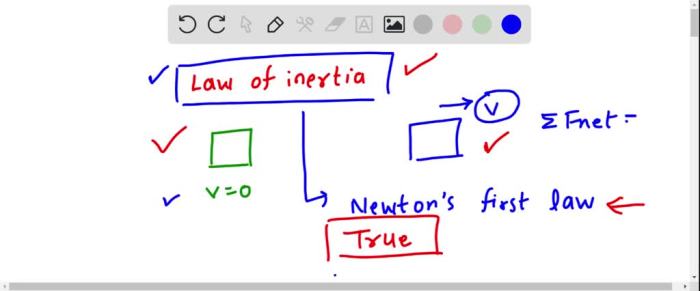
Newton’s First Law of Motion establishes the concept of inertia, which describes an object’s resistance to changes in its state of motion. However, to understand how objects actually move, we need to delve into the relationship between force and acceleration, which is the core of Newton’s Second Law of Motion.
Direct Proportionality Between Force and Acceleration
Newton’s Second Law of Motion states that the acceleration of an object is directly proportional to the net force acting on it and inversely proportional to its mass. This means that a larger force produces a larger acceleration, while a larger mass results in a smaller acceleration.
The mathematical representation of this law is:
F = m * a
where:
* F is the net force acting on the object
* m is the mass of the object
* a is the acceleration of the object
This relationship can be illustrated through various examples. For instance, if you push a shopping cart with a small force, it will accelerate slowly. However, if you push it with a larger force, it will accelerate more quickly. Similarly, if you push a heavy box with the same force as the shopping cart, it will accelerate more slowly due to its larger mass.
Examples of the Relationship Between Force and Acceleration
Here are some real-world examples that demonstrate the relationship between force and acceleration:
- Pushing a Car: If you push a car with a small force, it will accelerate slowly. However, if you push it with a larger force, it will accelerate more quickly. The acceleration is directly proportional to the force applied.
- Throwing a Ball: When you throw a ball, you exert a force on it, causing it to accelerate. The harder you throw the ball, the greater the force and the higher the acceleration.
- Rocket Launch: Rockets use powerful engines to generate immense thrust, which is the force that propels them upwards. The greater the thrust, the faster the rocket accelerates.
Applications of Newton’s First Law
Newton’s First Law of Motion, also known as the Law of Inertia, is a fundamental principle in physics that governs the motion of objects. This law has numerous applications across various fields, including engineering, aerospace, and transportation, influencing the design and functionality of systems and structures.
Engineering
Newton’s First Law plays a crucial role in various engineering disciplines. Its application in structural engineering ensures the stability and safety of buildings and bridges. Engineers consider the principle of inertia to design structures that can withstand forces and resist motion, ensuring their stability under various conditions.
Aerospace, What is newton’s first law of motion
In aerospace engineering, Newton’s First Law is fundamental to understanding and controlling the motion of spacecraft and aircraft. For instance, during launch, rockets utilize the principle of inertia to accelerate upwards, overcoming the force of gravity. Similarly, spacecraft in orbit maintain their motion due to inertia, continuing to move in a straight line at a constant speed unless acted upon by an external force.
Transportation
The application of Newton’s First Law is evident in transportation systems, particularly in the design and operation of vehicles. In automobiles, seatbelts are designed to restrain passengers during sudden stops or collisions, preventing them from continuing their motion due to inertia. Similarly, airbags are deployed to cushion the impact of collisions, minimizing the effects of inertia on passengers.
The principle of inertia is essential for understanding the behavior of objects in motion and at rest. It is applied in various fields to design and optimize systems, ensuring their stability and safety.
Ultimate Conclusion
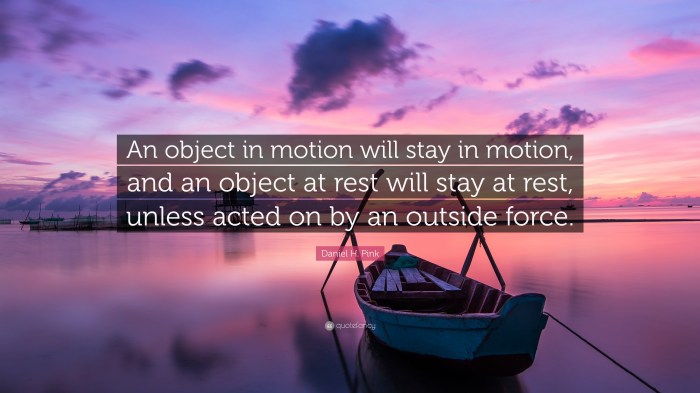
Newton’s first law of motion is a cornerstone of physics, providing a framework for understanding the motion of objects in our world. From the simple act of pushing a door to the complex orbits of planets, this law plays a vital role in explaining and predicting how things move. Understanding inertia and its implications allows us to design safer vehicles, build more efficient machines, and even explore the vast expanse of space.
FAQ
What is the difference between mass and inertia?
Mass is a measure of the amount of matter in an object, while inertia is the tendency of an object to resist changes in its motion. While they are related, they are not the same thing. Mass is a fundamental property of an object, while inertia is a consequence of that mass.
Does Newton’s first law apply to objects in space?
Yes, Newton’s first law applies to all objects, including those in space. In the absence of external forces, objects in space will continue moving at a constant velocity, even if that velocity is zero (i.e., they are at rest).
How does Newton’s first law relate to everyday life?
Newton’s first law is evident in many everyday situations. For example, when you’re riding a bike, you continue moving forward even after you stop pedaling. This is because of inertia. Similarly, when a car suddenly stops, you feel a force pushing you forward due to your body’s inertia.
